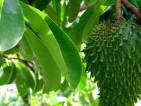Comparative Phytochemical Composition and Functional Group Detection of Annona muricata Linn Seeds and Leaves http://www.doi.org/10.26538/tjpps/v2i2.3
Main Article Content
Abstract
Annona muricata Linn (A. muricata) belongs to the Annonaceae family, it is well-known for its high nutritional index and therapeutic relevance in traditional medicine. Aim of the study: To determine and compare the bio-active compounds profiled from selected parts of the A. muricata plant. In addition, study findings is aimed at advancing pharmacological knowledge of selected plant parts of A. muricata. Gas chromatography-Mass spectrometry (GC-MS) and Fourier transform-infrared (FT-IR) spectroscopy were utilised to comparatively profile the phytochemical compositions of the ethanolic extracts of A. muricata seeds and leaves. From GC-MS analyses, nineteen phytochemical compounds were identified in the ethanolic extract of A. muricata seeds while eighteen phytochemical compounds were identified in the ethanolic extract of A. muricata leaves. Comparatively, cyanogenic glycosides, resveratrol and tannin were identified uniquely from A. muricata seeds, while the cardiac glycosides and anthocyanin were identified uniquely from A. muricata leaves. The FT-IR analyses confirmed the presence of C-Cl, C-O, C=C, N-H, SCN and -OH functional groups. However R2CHOH and R-COO were identified uniquely in A. muricata seeds and leaves respectively. These findings will be relevant in plant pharmacology and the development of enhanced medical strategies.
Metrics
Article Details

This work is licensed under a Creative Commons Attribution-NonCommercial 4.0 International License.
References
Moghadamtousi SZ, Fadaeinasab M, Nikzad S, Mohan G, Ali HM, Kadir HA. Annona muricata (Annonaceae): a review of its traditional uses, isolated acetogenins and biological activities. Int J. Mol Sci. 2015; 16(7):15625-15658. Doi:10.3390/ijms160715625
World Health Organization, Public Health Agency of Canada, Canada. Public Health Agency of Canada. Preventing chronic diseases: a vital investment. World Health Organization; 2005 Sep 28.
Jabir MS, Saleh YM, Sulaiman GM, Yaseen NY, Sahib UI, Dewir YH, Alwahibi MS, Soliman DA. Green synthesis of silver nanoparticles using Annona muricata extract as an inducer of apoptosis in cancer cells and inhibitor for NLRP3 inflammasome via enhanced autophagy. Nano. 2021;11(2):384. Doi:10.3390/nano11020384
Onuoha CH, Nwachukwu CC, Nwachukwu RT, Nwogu CG, Chukwudoruo CS, Ujowundu FN. Comparative evaluation of proximate composition and anti-sickling potential of Annona muricata Linn seeds and leaves. AROC Nat Prod Res. 2021; 1(2):29-35. Doi:10.53858/arocnpr01022935
Saraiva AL, Justino AB, Franco RR, Silva HC, Arruda FD, Klein SG, Celes MR, Goulart LR, Espindola FS. Polyphenols-Rich Fraction from Annona muricata Linn. Leaves Attenuates Oxidative and Inflammatory Responses in Neutrophils, Macrophages, and Experimental Lung Injury.
Pharmaceutics. 2022; 14(6):1182.Doi:10.3390/pharmaceutics14061182
Gavamukulya Y, Wamunyokoli F, El-Shemy HA. Annona muricata: Is the natural therapy to most disease conditions including cancer growing in our backyard? A systematic review of its research history and future prospects. Asian Pac J. Trop Med. 2017; 10(9):835-848. Doi: 10.1016/j.apjtm.2017.08.009
Coria-Téllez AV, Montalvo-Gónzalez E, Yahia EM, ObledoVázquez EN. Annona muricata: A comprehensive review on its traditional medicinal uses, phytochemicals, pharmacological activities, mechanisms of action and toxicity. Arab J. Chem. 2018; 11(5):662-691. Doi: 10.1016/j.arabjc.2016.01.004
Agu KC. Computer-Aided Screening of the Binding Affinities of Some Anti-Diabetic Ligands Obtained from Annona muricata Linn.(Soursop) and their Derivatives against Alpha-glucosidase. Phy Plu. 2022; 2(2):100272. Doi: 10.1016/j.phyplu.2022.100272
Emwas AH, Al-Talla ZA, Yang Y, Kharbatia NM. Gas chromatography–mass spectrometry of biofluids and extracts. Metab: Met Prot. 2015; 91-112. Doi:10.1007/978- 1-4939-2377-9_8
Nakamizo S, Sasayama T, Shinohara M, Irino Y, Nishiumi S, Nishihara M, Tanaka H, Tanaka K, Mizukawa K, Itoh T, Taniguchi M. GC/MS-based metabolomic analysis of cerebrospinal fluid (CSF) from glioma patients. J. Neuroonco. 2013; 113:65-74. Doi:10.1007/s11060-013-1090-x
Patrizi B, Siciliani de Cumis M, Viciani S, D’Amato F. Dioxin and related compound detection: Perspectives for optical monitoring. Int. J. Mol Sci. 2019; 20(11):2671. Doi:10.3390/ijms20112671
Ramaiah K, Prashanth J, Haribabu J, Srikanth KE, Reddy BV, Karvembu R, Reddy KL. Vibrational spectroscopic (FTIR, FT-Raman), anti-inflammatory, docking and molecular characteristic studies of Ni (II) complex of 2-aminonicotinaldehyde using theoretical and experimental
methods. J. Mol. Str. 2019; 1175:769-781.Doi:10.1016/j.molstruc.2018.08.044
Pakkirisamy M, Kalakandan SK, Ravichandran K. Phytochemical screening, GC-MS, FT-IR analysis of methanolic extract of Curcuma caesia Roxb (Black Turmeric). Pharma J. 2017; 9(6). Doi: 10.5530/pj.2017.6.149
Francisco IA, Pinotti MH. Cyanogenic glycosides in plants. Bra Arch Biol Tech. 2000; 43:487-92. Doi:10.1590/S1516-89132000000500007
Michalcová K, Halenár M, Kolesárová A. Cyanogenic glycosides as a potential bioregulator. J. Micro Biotech Food Sci. 2021; 743-746. Doi:10.15414/jmbfs.2016.6.1.743-746
Adewusi SR, Oke OL. On the metabolism of amygdalin. 2. The distribution of β-glucosidase activity and orally administered amygdalin in rats. Can J. Phys Pharm. 1985; 63(9):1084-1087. Doi:10.1139/y85-178
Salehi B, Mishra AP, Nigam M, Sener B, Kilic M, SharifiRad M, Fokou PV, Martins N, Sharifi-Rad J. Resveratrol: A double-edged sword in health benefits. Biomedicines. 2018;6(3):91. Doi: 10.3390/biomedicines6030091
Pezzuto JM. Resveratrol as an inhibitor of carcinogenesis. Pharma Bio. 2008; 46(7-8):443-573. Doi: 10.1080/13880200802116610
Baer-Dubowska W, Szaefer H, Majchrzak-Celińska A, Krajka-Kuźniak V. Tannic acid: specific form of tannins in cancer chemoprevention and therapy-old and new applications. Curr Pharma Rep. 2020; 6:28-37. Doi: 10.1007/s40495-020-00211-y
Karakurt S, Adali O. Tannic acid inhibits proliferation, migration, invasion of prostate cancer and modulates drug metabolizing and antioxidant enzymes. Anti-Can AgentsMed Chem (Formerly Curr Med Chem-Anti-Can Agents). 2016; 16(6):781-789.
Jordan LG, Booth BW. HER2+ breast cancer cells undergo apoptosis upon exposure to tannic acid released from remodeled cross‐linked collagen type I. J. Biom Mat Res Part A. 2018; 106(1):26-32. Doi: 10.1002/jbm.a.36205
Winnicka KA, Bielawski KR, Bielawska AN. Cardiac glycosides in cancer research and cancer therapy. Acta Pol Pharm. 2006; 63(2):109-115.
Prassas I, Diamandis EP. Novel therapeutic applications of cardiac glycosides. Nat Rev Drug Disc. 2008; 7(11):926- 935. Doi: 10.1038/nrd2682
Triana-Martínez F, Picallos-Rabina P, Da Silva-Álvarez S, Pietrocola F, Llanos S, Rodilla V, Soprano E, Pedrosa P, Ferreirós A, Barradas M, Hernández-González F. Identification and characterization of Cardiac Glycosides as senolytic compounds. Nat Comm. 2019; 10(1):4731. Doi:
1038/s41467-019-12888-x
Newman RA, Yang P, Pawlus AD, Block KI. Cardiac glycosides as novel cancer therapeutic agents. Mol Int. 2008;8(1):36. Doi: 10.1124/mi.8.1.8
Einbond LS, Reynertson KA, Luo XD, Basile MJ, Kennelly EJ. Anthocyanin antioxidants from edible fruits. Food Chem.2004; 84(1):23-28. Doi: 10.1016/S0308-8146(03)00162-6
Liu Y, Tikunov Y, Schouten RE, Marcelis LF, Visser RG, Bovy A. Anthocyanin biosynthesis and degradation mechanisms in Solanaceous vegetables: A review. F Chem.2018; 6:52. Doi: 10.3389/fchem.2018.00052


